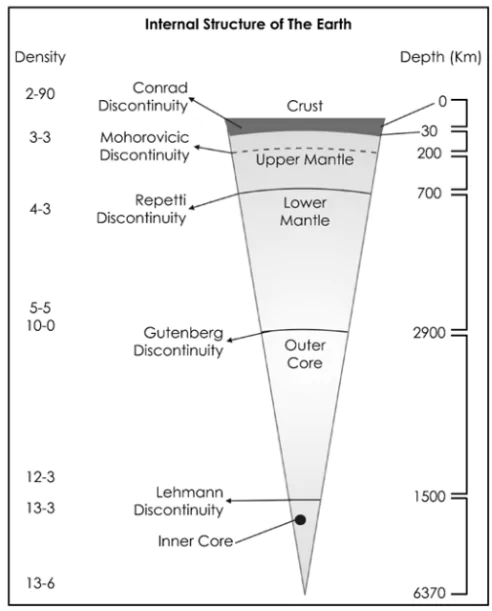The structure of the Earth’s interior is made up of several concentric layers. The heat from the Earth’s formation and radioactive decay creates convection currents, driving movement in these layers. Earthquakes, volcanic activity, and magnetic field generation are all influenced by processes within the Earth’s interior. Temperature and pressure increase as we go deeper towards the centre of the Earth because of the presence of radioactive materials. Broadly, three layers can be identified:
What are the primary sources of information used to understand Earth’s interior?
- Inaccessible Earth’s Interior: Reaching the centre of the Earth to make direct observations or collect samples is currently impossible.
- Most of our understanding of the earth’s interior is based on estimates, inferences, and indirect evidence, though some information is derived from direct observations and analysis of materials.
- Direct Sources: The most readily available material from the earth is surface rock and the rocks obtained from mining.
- Gold mines in South Africa extend to depths of 3-4 km, with mining becoming unfeasible beyond this due to extreme heat.
- Notable projects such as the “Deep Ocean Drilling Project” and the “Integrated Ocean Drilling Project” have aimed to explore deeper depths.
- The deepest drilling, located in the Arctic Ocean at Kola, has penetrated to a depth of 12 km.
- Direct insights into Earth’s interior can also be gleaned from molten material (magma) during volcanic eruptions, although the precise depth of the magma source remains uncertain.
- Indirect Sources: The property of matter provides clues about conditions inside the Earth.
- Mining reveals that temperature, pressure, and density rise as you go deeper into the earth.
- Changes in these characteristics help estimate conditions at different depths underground.
- Meteors: Meteors that reach Earth offer another way to learn about our planet.
- Although they don’t come from inside the Earth, their makeup is thought to be similar to ours.
- Other Indirect Sources:
- Gravitation: Differences in gravitational force at different latitudes (gravity anomalies) can hint at the distribution of mass within the earth’s crust.
- Magnetic Field: Magnetic surveys provide details about the distribution of magnetic materials in the crust.
- Seismic Activity: This is a crucial source of information about the Earth’s interior and will be discussed in detail in the subsequent sections of the chapter.
Enroll now for UPSC Online Course
Earth’s Interior: Layers, Discontinuities and Sources
Crust
- Earth’s outermost layer which is solid and brittle.
- Continental Crust: mean thickness = 30 km & density = 2.7g/cm3;
- Rock Type: Granite; Minerals – Silica + Aluminium = SIAL
- Conrad Discontinuity: The boundary between upper crust and lower crust.
 Oceanic Crust: Thinner than Continental Crust,
Oceanic Crust: Thinner than Continental Crust, -
- Mean Thickness = 5km;
- Density = 3g/cm3;
- Rock type: Basalt;
- Minerals mean thickness =Silica + Iron + Magnesium=SIMA
Mantle
- Extends from Moho’s discontinuity to a depth of 2,900 km.
- Asthenosphere: Upper portion of the mantle is called the asthenosphere. It is the main source of magma.
- Density: It is higher than the continental crust.
- Mohorovicic Discontinuity: boundary between lower crust and upper mantle.
- Repetti Discontinuity: transition zone between upper mantle and lower mantle.
- Lithosphere: This solid layer comprises the crust and the uppermost part of the mantle. Its thickness varies between 10 km and 200 km.
- Lower Mantle: Positioned below the asthenosphere, remains solid, extending down to the Earth’s core.
Core
- Starts at a depth of 2,900 km;
- Outer Core: It is liquid, mainly because of its high temperature, while the inner core remains solid despite even greater temperatures due to the immense pressures at this depth.
- Composition: Predominantly made up of heavy materials i.e. “nife” layer (Nickel and Iron)
- Gutenberg Discontinuity: Transition zone between lower mantle and outer core.
- Lehmann Discontinuity: Transition zone between outer and inner cores.
- Sources to study the interior of the earth:
- Direct Source: surface rocks, volcanic eruption, Deep ocean drilling project etc.
- Indirect Sorce: mining activity, meteors, gravitation, magnetic field, and seismic activity.
Conclusion
Our understanding of Earth’s interior comes from both direct and indirect sources. Direct observations include surface rocks, volcanic eruptions, and deep drilling projects, while indirect methods involve analyzing seismic activity, gravitational anomalies, and magnetic surveys. Through these means, we’ve uncovered a layered structure, from the solid and brittle crust to the liquid outer core and solid inner core, providing insights into our planet’s dynamic and complex inner workings.
![]() April 26, 2024
April 26, 2024
![]() 2942
2942
![]() 0
0
 Oceanic Crust: Thinner than Continental Crust,
Oceanic Crust: Thinner than Continental Crust,